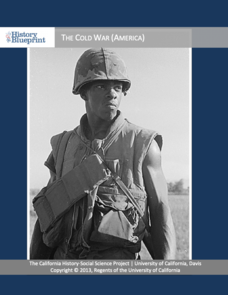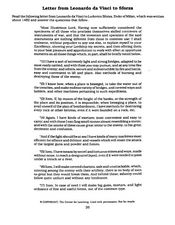Curated OER
Forty Acres? The Question of Land at the War's End
Should land be redistributed to former slaves after the Civil War? This essential question guides a activity on the Reconstruction Era, as learners analyze primary sources (linked), recording responses on a worksheet (linked). To model...
Curated OER
Finding James Fort
Welcome to Jamestown! Third and fourth graders read and analyze primary source documents about Jamestown or Fort James. They read and analyze descriptions of Fort James from primary sources. They access a website to explore more...
Curated OER
Create a Walking Tour of San Francisco's Chinatown
Take a tour of Chinatown as it was in the 1800's. Analyzing primary source images and documents, learners will gain a better understanding of the myths and misconceptions of Chinese immigrants during the 1800's. They create a pamphlet to...
University of California
The Cold War (America)
The Cold War—with its roots in World War II—impacts the world today. Using an extensive curriculum, scholars consider its impact through primary sources, including speeches and propaganda, as well as other skills-enhancing activities. An...
Humanities Texas
Primary Source Worksheet: Excerpt of Senate Bill Proposing an End to the Slave Trade
To sign or not to sign? That is the question facing readers of the 1807 bill proposing an end to the slave trade. After a close reading of excerpts from the bill, readers are asked to advise Thomas Jefferson either to sign or reject the...
Humanities Texas
Primary Source Worksheet: Excerpt from Reagan's Speech "A Time for Choosing"
An excerpt from Ronald Reagan's October 27, 1964 speech in support of presidential nominee Barry Goldwater, "A Time for Choosing," is the text for primary source analysis activity. After reading the document, learners respond to seven...
Historical Thinking Matters
Social Security: 3 Day Lesson
What does social security reveal about the political and social culture of the 1930s? After beginning with a brief introductory video on the impact of the Great Depression and how various Americans, such as Huey Long and Francis...
Historical Thinking Matters
Spanish-American War: 3 Day Lesson
Why did the United States choose to invade Cuba in 1898? As part of a 3-day lesson, your young historians will first develop working hypotheses to answer this question, then work with a variety of historical primary source documents that...
Center for History Education
The Tobacco Economy: How did the Geography of the Chesapeake Region Influence its Development?
Explore the relationship between geography and economy using primary sources. After examining wills, advertisements, and other primary sources, individuals consider how the Chesapeake Region came to be home first to indentured servants,...
Curated OER
How Were European Nations Capable of Dominating the African Continent?
Primary source documents provide a realistic context for pupils to explore. Included are 5 experts relating European ideals and methods for colonizing and controlling the African continent. Middle schoolers answer 4 critical-thinking...
Curated OER
Written Document Analysis
For this primary source analysis worksheet, students examine types of written documents and respond to 6 analysis questions about them.
Curated OER
Immigration Debates in the Era of "Open Gates"
Young social historians examine immigration debates of the early 20th century through primary sources, such as political cartoons. They analyze the material, discuss their findings, and complete a critical thinking worksheet. All...
Curated OER
Invetories Slave owner or not?
Primary source analysis is a great way to bring history to life. Learners examine a series of personal inventories taken from Southern white males who died during the Civil War era. They analyze the documents to determine the social and...
Curated OER
Little House in the Census: Almanzo and Laura Ingalls Wilder
How would you use census data from 1880-1900? Here are a set of ways you can incorporate the book Little House on the Prairie and US census data from that time period. Learners will research the validity or the book based on factual...
Curated OER
What Were the Main Achievements of the Mayan Civilization?
Guided reading questions can keep kids focused. Here they read about Mayan Civilization and then answer 9 fill-in-the-blank questions. They must use evidence from their readings to support their answers. The worksheet includes 3...
Curated OER
Children of War
Take a closer look at the impact of war in this language arts and social studies lesson. Middle schoolers use primary sources to conduct research as they relate to the effects of war on children. They compare and contrast the effects of...
Curated OER
Who Fought for the Union?
Learners read New York Times articles, letters, and listen to songs written from a soldier's perspective during the Civil War in order to understand who was fighting in the Union Army. This is a great lesson, complete with weblinks,...
Curated OER
Letter from Leonardo da Vinci to Sforza
Expose your class to words directly from Leonardo da Vinci with this primary source document. Learners analyze the document, a letter from Leonardo da Vinci to Ludovico Sforza, the Duke of Milan, and respond to 3 short answer questions....
Curated OER
Propaganda, WWII, Ghetto‘s, and Analysis of Primary Resources
Students consider the implications of anti-Semitism. In this World War II lesson, students examine selected documents and images featuring the propaganda that promoted Jewish persecution. Students write essays that highlight how the Nazi...
Skyscraper Museum
Building a Skyscraper
The construction of skyscrapers is no simple undertaking, involving the careful coordination and planning of many different people. The third activity in this series explores this detailed process by first teaching children about the...
DocsTeach
Documenting Key Presidential Decisions
It's match time! Academics participate in an exciting matching game using primary sources. The activity uses documents of key decisions and matches them to the presidents that they are attributed to. Scholars also make a list of key...
Curated OER
The Third Estate
Kids read a translated version of Abbe Sieyes' document, The Third Estate. This document is shown in its original form and as an English translation. After reading the text they answer three critical thinking question to show their...
Digital Public Library of America
The Watsons Go To Birmingham—1963 by Christopher Paul Curtis
A primary source set of photographs, videos, newspaper articles, and FBI reports provides insight into race relations during the 1960s, the Sixteenth Street Baptist Church bombing, and the murder of Emmitt Till. Designed to be used to...
New York State Education Department
US History and Government Examination: January 2012
What led to the United States Civil War? Interested historians consider a variety of political, social, and economic factors using primary sources and an essay prompt in an authentic high-stakes test. Primary sources include political...

























